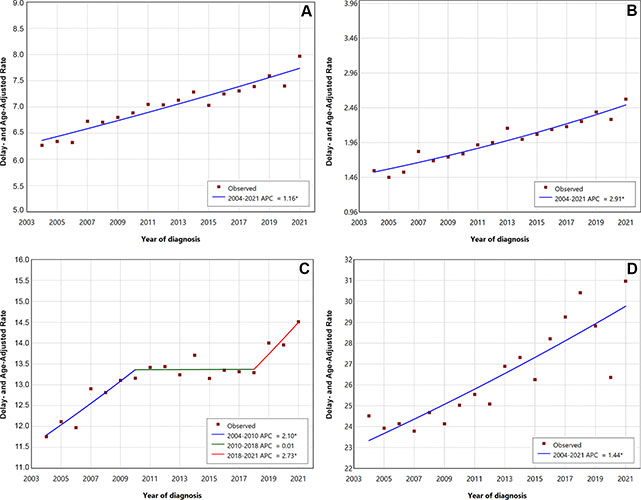Late-Stage Breast Cancer Diagnosis on the Rise in U.S.
Alarming new finding shows significant increase in metastatic disease at diagnosis among all U.S. women, across all age groups


The number of women with late-stage, invasive breast cancer at the time of diagnosis increased significantly among U.S. women across all ages and ethnicities between 2004 and 2021, according to a study published in Radiology.
In the study, researchers analyzed the latest available Surveillance, Epidemiology and End Results (SEER) data on annual stage-specific breast cancer incidence rates between 2004 and 2021. SEER data is collected from 22 population-based cancer registries covering approximately 48% of the U.S. population.
The researchers evaluated trends in women presenting with metastatic breast cancers overall, and by age group and ethnicity.
“It’s important to understand that these women presented with distant (metastatic or Stage 4) breast cancer at the time of diagnosis,” said co-author Debra L. Monticciolo, MD, past president of the American College of Radiology. “Women with this diagnosis have a much lower survival rate and are much harder to treat.”
According to the U.S. Centers for Disease Control and Prevention, breast cancer is the second most common cause of cancer death after lung cancer for U.S. women. Five-year survival rates are 31% for metastatic invasive breast cancers, compared to 99% and 86%, respectively for localized and regional invasive breast cancers.
Between 2004 and 2021, the biggest annual percentage increase in the incidence of metastatic breast cancer at diagnosis occurred in women between the ages of 20 and 39 (2.9%). For women aged 40–74 years, the researchers observed annual percentage increases of 2.1% and 2.7%, respectively, during two time periods from 2004–2012 and 2018–2021.
“It’s been previously reported that metastatic breast cancer at initial presentation has increased significantly for women under 40, but until now, no clear trend in older women has been reported,” Dr. Monticciolo said.
For women aged 75 years and older, the incidence rate increased by 1.4% over the study period.
“The significant increase in metastatic disease at diagnosis among all U.S. women and across all age groups is an alarming new finding,” said lead author R. Edward Hendrick, PhD, clinical professor, department of radiology at the University of Colorado Anschutz School of Medicine. “This finding is even more remarkable given the likely undercounting of advanced disease in 2020 due to the COVID-19 pandemic.”

Graphs of best joinpoint fits of Surveillance, Epidemiology, and End Results (SEER) 22 data for delay-adjusted and age-adjusted annual incidence rates of distant-stage breast cancer (per 100 000 women) for U.S. women (A) of all ages, (B) aged 20–39 years, (C) aged 40–74 years, and (D) aged 75 years or older. APC = annual percentage change, * = APC significantly different from zero with α = .05.
https://doi.org/10.1148/radiol.241397 © RSNA 2024
Examining Changes Across Demographic Groups
During the COVID-19 pandemic, radiology volumes declined sharply, especially for breast imaging. Researchers said the disruption in breast screening and diagnostic examinations raised concerns about downstream effects.
“During the pandemic, we saw steep drops in the number of older, minority women being screened,” Dr. Monticciolo said. “This population tends to get left behind when any stress occurs in the health care system.”
Across ethnicities, Native American women had the largest annual percentage change in the incidence of metastatic breast cancer at diagnosis at 3.9%. The incidence rate also significantly and rapidly increased for Asian women at a rate of 2.9% per year between 2004 and 2021.
The annual percentage change among Black and Hispanic women was .86% and 1.6%, respectively. Among white women, there was an increase of 1.7% from 2004–2012, but no trend after that. Incidence rates of distant-stage breast cancers were 55% higher in Black women compared to white women.
The researchers said several factors may be contributing to the increased incidence of metastatic breast cancer at diagnosis, including the lack of a national, organized screening program and inconsistent screening guidelines, which discourage screening attendance.
“Fewer than 50% of U.S. women participate in annual breast cancer screening,” Dr. Monticciolo said. “That means we don’t have the opportunity to sweep out early-stage breast cancers in huge numbers of women, who will arrive at a later stage for diagnosis.”
Factors Contributing to the Trend
U.S. Preventive Services Task Force (USPSTF) guidelines currently recommend that women between 40 and 74 undergo a screening mammogram every two years.
“The USPSTF guidelines leave out women over age 74, despite the clear advantages of early detection,” Dr. Monticciolo said. “And younger women don’t get the chance to be screened, when as a population, they are more likely to be diagnosed with aggressive, fast-growing cancers.”
Other contributing factors to the trends observed in the study include increasing obesity rates, reproductive trends, a lack of access to quality health care and environmental factors.
The National Comprehensive Cancer Network recommends that women undergo a breast cancer risk assessment by the age of 25 to evaluate their overall risk for the disease.
The researchers said more study is needed, particularly of the Black population, who are more likely to experience advanced breast disease at a younger age.
For More Information
Access the Radiology study, “Surveillance, Epidemiology, and End Results Data Show Increasing Rates of Distant-Stage Breast Cancer at Presentation in U.S. Women,” and the related editorial, “Distant-Stage Breast Cancer Incidence Is Increasing in U.S. Women across Age Groups and Race and Ethnicity Groups.”
Read previous RSNA News stories on breast imaging: